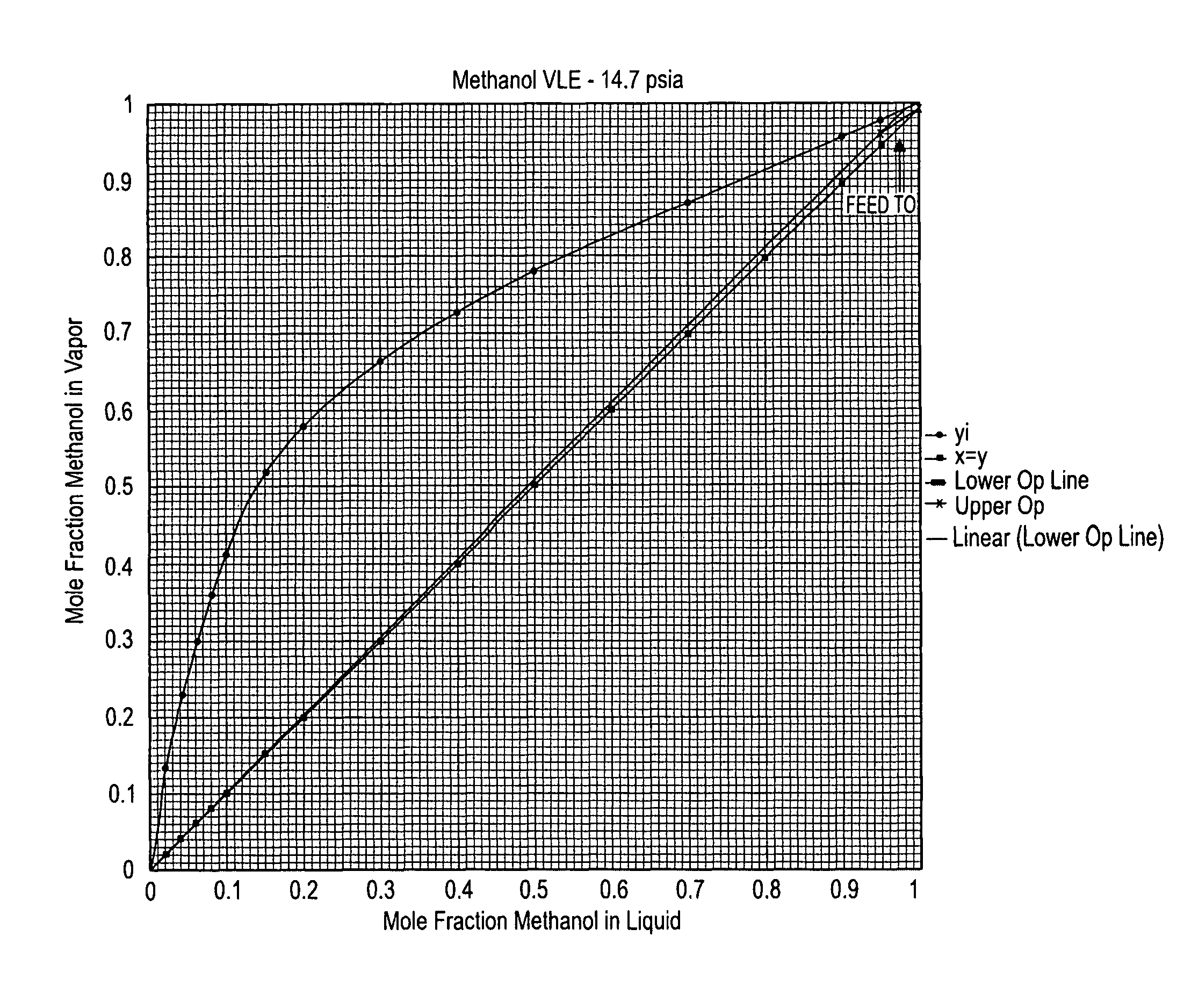Use of pressure swing absorption for water removal from a wet methanol stream
a technology of pressure swing and wet methanol, which is applied in the separation/purification of carboxylic acid esters, oxygen-containing compound preparations, biofuels, etc., can solve the problems of large number of distillation plates, high capital investment cost, and complex process of dehydrating an alcohol from a wet methanol or other wet alcohol stream, so as to achieve efficient recovery of excess alcohol and high purity
- Summary
- Abstract
- Description
- Claims
- Application Information
AI Technical Summary
Benefits of technology
Problems solved by technology
Method used
Image
Examples
example 1
[0083]Comparison of the heat required to distill a methanol / water mixture versus vaporization of a comparable feed for use in pressure swing adsorption is made. Calculation of the heat required for distillation separation is made with reference to FIG. 1—the vapor liquid equilibrium (VLE) x-y diagram for methanol at atmospheric pressure. The curved line is the x-y equilibrium. The diagonal red line is x=y. A feed stream with a high methanol content limits the column operation to operating lines for the stripping section that must run very close to the x=y diagonal. Since the ratio of the molar flow of liquid methanol (L) to the molar flow of vapor methanol (V) at the bottom of the column is equal to 1.0404 (based on the simulation) and V+B=L at the bottom (where B is defined as the molar flow of bottoms), V then is equal to B / 0.0404.
[0084]With a bottoms water draw of 47.17 lbmole / hr that results in 1167.57 lbmole / hr of vapor which is all water vapor and a bottoms heat input of 20,38...
example 2
[0086]Simulations of a two-bed pressure swing adsorption system constructed according to the system disclosed in FIG. 2 were performed. Operating conditions including cycle time, absorption pressure (PH), regeneration pressure (PL), bed length (L), bed diameter (D), and number of cycles is also found for each case in Table 1. Simulations of this type start at an initial point and run for many cycles until a pseudo steady state is established. At about 1500 cycles, in the case of these simulations, the behavior of the beds from cycle to cycle no longer change and remain consistent. Similar simulations of a three-bed PSA system constructed according to the system disclosed in FIG. 2 were performed. Operating conditions including cycle time, absorption pressure (PH), regeneration pressure (PL), bed length (L), bed diameter (D), and number of cycles is also found for each case in Table 2.
[0087]Results are shown after 350 and 1500 cycles for each study. In some cases steady state was not...
PUM
| Property | Measurement | Unit |
|---|---|---|
| wt. % | aaaaa | aaaaa |
| wt. % | aaaaa | aaaaa |
| wt. % | aaaaa | aaaaa |
Abstract
Description
Claims
Application Information
 Login to View More
Login to View More - R&D
- Intellectual Property
- Life Sciences
- Materials
- Tech Scout
- Unparalleled Data Quality
- Higher Quality Content
- 60% Fewer Hallucinations
Browse by: Latest US Patents, China's latest patents, Technical Efficacy Thesaurus, Application Domain, Technology Topic, Popular Technical Reports.
© 2025 PatSnap. All rights reserved.Legal|Privacy policy|Modern Slavery Act Transparency Statement|Sitemap|About US| Contact US: help@patsnap.com



